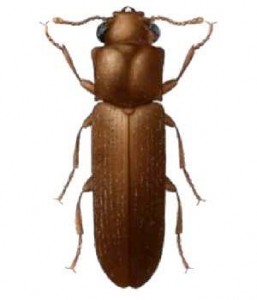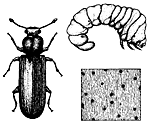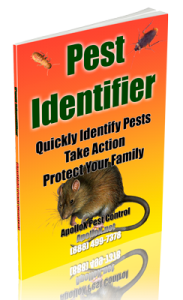Powderpost Beetle Hunt – What are they?

Powderpost beetles are small wood-boring pests that can do great damage to your furniture and home. The problem begins when an adult powderpost beetle lays eggs in exposed wood (for example, furniture, your home’s framework, foundation or siding). When the eggs hatch, the powderpost beetle larvae do the damage. They feed on the wood, tunneling through it, for up to 5 years. The larvae then mature to adults and exit the wood looking for a mate (usually in the Spring). Powderpost beetles might live only a few days as adults. Once they find a mate, they lay eggs in the wood, die, and the cycle repeats, only with more powderpost beetles drilling around inside the wood, consuming it and turning it to dust!
Image credits: How to Tell if you Have Powder Post Beetle Damage | Sunstate Pest …
Learn more about three types of powderpost beetles, what wood each loves to eat, and how to differentiate them based on the exit holes they make in wood, and the sawdust they push out of their exit holes as they mature.
Powderpost Beetle Hunt – How do you know if you have them?
 Look closely at the wood that makes up your home, and at furniture, particularly furniture in storage or furniture that you may have purchased as used or as antiques. Any wood that was imported is particularly susceptible. Why? Not all countries observe proper kiln drying standards for lumber, and powderpost beetles love lumber that is damp. If you built something using old wood that had been lying around in a garage, basement or barn, that is also susceptible. Wood siding, flooring or framing that has been stored in damp conditions without good ventilation is also susceptible.
Look closely at the wood that makes up your home, and at furniture, particularly furniture in storage or furniture that you may have purchased as used or as antiques. Any wood that was imported is particularly susceptible. Why? Not all countries observe proper kiln drying standards for lumber, and powderpost beetles love lumber that is damp. If you built something using old wood that had been lying around in a garage, basement or barn, that is also susceptible. Wood siding, flooring or framing that has been stored in damp conditions without good ventilation is also susceptible.
Powderpost Beetle Hunt – What to look for?
Look for small pinhole marks in the wood. These marks represent the exit holes the powderpost beetles made after they matured into adults. You might also notice very fine sawdust, called frass, at the base of the wood. The beetles push this sawdust out of the hole as they exit.
Powderpost Beetle Hunt – What to do?
First, make sure that the powderpost beetles are still active. You can do this by cleaning up any sawdust (frass) they’ve created, then return later to see if there is new sawdust.
Second, dry out the location and provide proper ventilation around the wood. Simply by drying out the environment, you may entice the bugs to move elsewhere.
Third, sand and varnish the wood. This will prevent any powderpost beetles from laying new eggs in the wood. They can only lay their eggs in unfinished wood. However, if there are powderpost beetle larvae already in the wood varnishing the wood will not solve the problem (remember they live and tunnel about, consuming wood for up to 5 years causing a lot of damage).
Fourth, if you suspect that there might be an active infestation (living powderpost beetle larvae tunneling about inside the wood), you’ll want to contact a pest control professional. One of the most effective methods for eliminating powderpost beetles is fumigation with a pesticide that only a licensed pest exterminator is allowed to purchase.
Powderpost Beetle Hunt – This is a serious issue.
So, if you see small pinholes in that antique table you recently purchased, or in your home’s siding or framework, or in the wood you brought up from the basement to use in your latest home improvement project… don’t ignore the issue. The integrity of your home could be compromised by a powderpost beetle problem.
You don’t need to panic, as the beetles do their damage slowly over time, giving you enough time to assess the problem and take the appropriate action. For example, do the above test (sawdust cleanup) this Spring, then check again next Spring to see if there is new sawdust.
But don’t ignore the problem. As they say, “The wheels of justice grind slowly, but they grind exceedingly fine.” Same with the work of powderpost beetles! Leave them to do their work and they’ll eventually disintegrate the wood they infest. In addition, when you go to resell your home at some point, imagine the value dropping drastically when the buyer’s home inspector discovers a powderpost beetle problem that was left untreated. Bad Bad!












Recent Comments